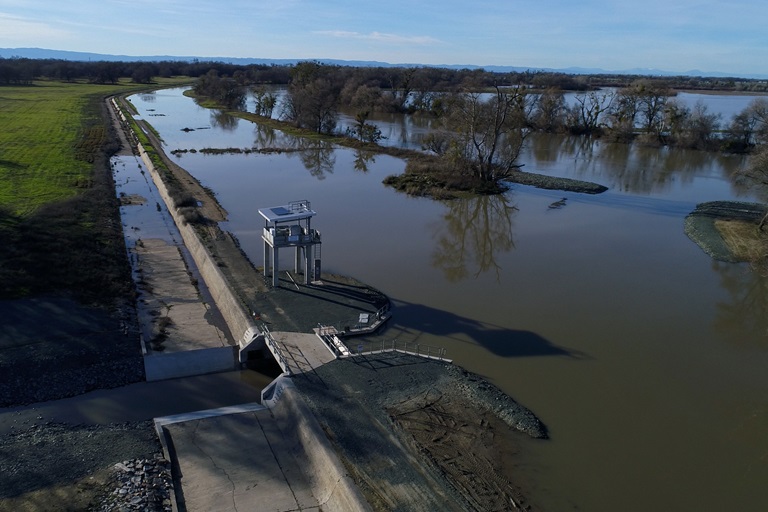DWR Gets Fish Friendly with Retooled Infrastructure in Yolo Bypass
View of the Fremont Weir Adult Fish Passage structure at the north end of the Yolo Bypass. DWR/2019
Editor’s note: The following article is part of a continuing series highlighting the California EcoRestore Initiative, which seeks to restore 30,000 acres of habitat in the Sacramento-San Joaquin Delta by 2020. California EcoRestore is an umbrella program that includes habitat restoration efforts implemented by departments under the California Natural Resources Agency including Department of Water Resources, Department of Fish and Wildlife, and Delta Conservancy. This EcoRestore project is paid for with funding from the State Water Project.
The Sacramento River moves water from Mt. Shasta to the Sacramento-San Joaquin Delta, gathering runoff from the Coastal Range and Sierra Nevada before turning toward Sacramento and joining with the American River. In wetter years, the Sacramento River swells to flood levels and releases water into the Yolo Bypass, a major flood control feature for the Sacramento Valley.
At 59,000 acres, the Yolo Bypass can hold four times the capacity of water as the Sacramento River.
The primary trigger for river releases into the bypass is the Fremont Weir, a 1.8-mile concrete wall that automatically overtops when the Sacramento River reaches a designated high-water mark. Water flows over the weir every two out of three years on average.
Built in 1924 by the U.S. Army Corps of Engineers, the Fremont Weir has been hailed as a simple yet impressive feat in sustainable flood protection and engineering.
What About the Fish?
The weir design, while forward-thinking at the time, revealed unintended consequences over time. Scientists discovered that when the Sacramento River overtopped the weir to flow into the Yolo Bypass, many adult Chinook salmon, steelhead, and sturgeon were delayed or stranded in the bypass.
As the fish, several of which are designated endangered or threatened species, swim north against the river’s current toward their spawning ground, they often mistakenly swim into the Yolo Bypass instead of staying in the river’s main channel. Some fish never make it back to the river. Even if they do, the diversion causes migration delays that may result in fish not spawning that year.
In 1965, the California Department of Fish and Wildlife (CDFW) built a “fish ladder” to help salmon, but over time scientists and engineers found that many fish were still marooned in the bypass. The fish ladder was an insufficient portal to pass through the weir.
A Modern Solution with Multiple Benefits
In 2018, DWR and the U.S. Bureau of Reclamation (Reclamation) updated the fish ladder with a deeper, wider passageway in the weir to facilitate fish passage from the bypass to the river. In designing the Fremont Weir Adult Fish Passage Modification Project, DWR and Reclamation worked with an array of scientists, engineers and landowners from different organizations, including California Trout and American Rivers.
The design features an open channel fishway and a modern gate structure that automatically opens when water overtops at the Fremont Weir.
“The project allows fish to return to the Sacramento River. This connection improves fish passage and reduces the likelihood of fish getting stranded in the Yolo Bypass,” said Manny Bahia, DWR senior water resources engineer.
The passage corridor also accommodates migrating sturgeon, which can grow up to six feet long.
The retrofitted Fremont Weir will begin operations in winter 2019. DWR and Reclamation collaborated on the project in compliance with the 2009 biological opinion from the National Marine Fisheries Service to offset harm to fish populations caused by the State Water Project and Central Valley Project.
“Every adult fish we save helps protect the species. One adult that makes it to the spawning grounds can lay thousands of eggs,” said Karen Enstrom, program manager for the Yolo Bypass Habitat Restoration Branch at the Department of Water Resources.
Beyond flood control and fish habitat, the Yolo Bypass of today provides an array of benefits including waterfowl habitat, agriculture, recreation, and cultural preservation.
The Fremont Weir Adult Fish Passage Modification Project is one of many restoration and infrastructure improvements within the Yolo Bypass aimed at boosting salmon survival rates. Other projects include the Wallace Weir Adult Fish Rescue Facility, the Yolo Bypass Salmonid Habitat Restoration and Fish Passage Project, and the Lower Putah Creek Restoration Project.
Learn more about these projects on our website.
Contact:
Allen Young, Information Officer, Department of Water Resources
916-653-3925 | allen.young@water.ca.gov
Charlotte Biggs, Program Manager, Department of Water Resources
916-651-2997 | charlotte.biggs@water.ca.gov
